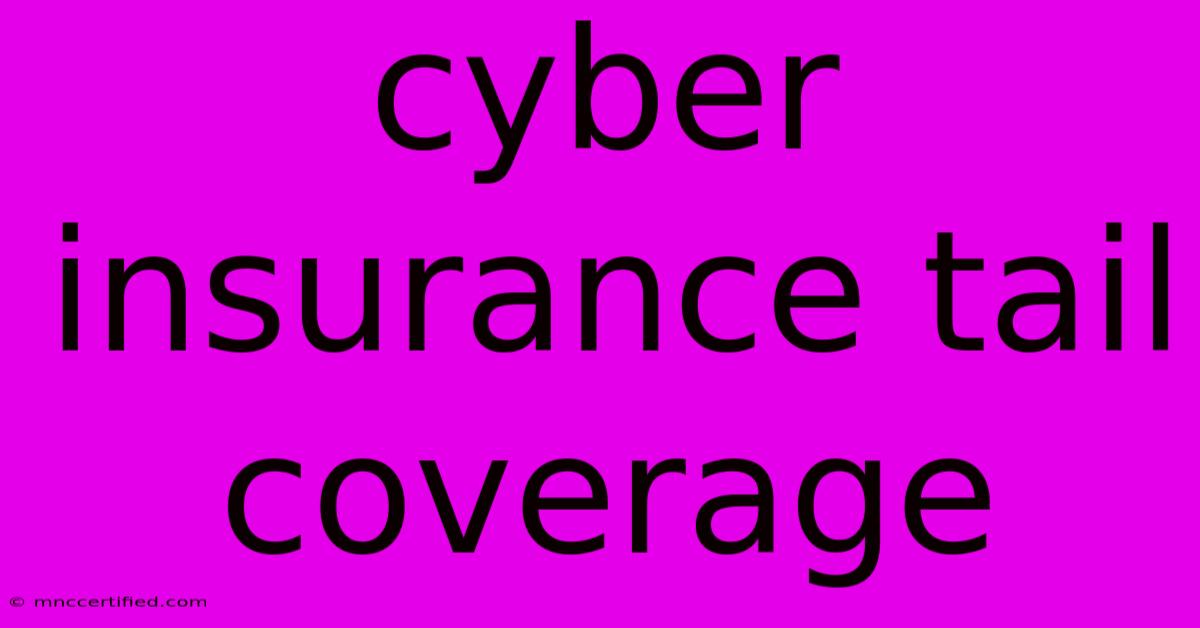Cyber Insurance Tail Coverage

Table of Contents
Cyber Insurance Tail Coverage: Protecting Your Business After Policy Expiration
Cyber threats are ever-evolving, and the aftermath of a data breach can linger long after the initial incident. This is where cyber insurance tail coverage becomes crucial. Understanding what it is, why you need it, and how it works is essential for any business operating in today's digital landscape. This comprehensive guide will walk you through everything you need to know about cyber insurance tail coverage.
What is Cyber Insurance Tail Coverage?
Cyber insurance tail coverage, also known as extended reporting period (ERP) coverage, is an add-on to your primary cyber liability insurance policy. It provides continued protection against claims arising from incidents that occurred during your original policy period, even after that policy has expired. Think of it as an extension of your existing coverage, offering a safety net for potential future liabilities.
Without tail coverage, once your policy expires, so does your protection. This leaves your business vulnerable to lawsuits, regulatory fines, and other costs associated with data breaches or cyberattacks that may not surface until months or even years later.
Why is Cyber Insurance Tail Coverage Important?
The delayed discovery of cyber incidents is a significant concern. Data breaches often go undetected for considerable periods. The effects can be devastating, including:
- Lawsuits: Victims of a data breach may not file lawsuits immediately.
- Regulatory investigations: Investigations by authorities can take a long time to conclude, resulting in delayed fines or penalties.
- Reputational damage: The long-term impact on your brand reputation can significantly affect your bottom line.
Tail coverage acts as a crucial buffer against these potential financial and reputational risks. It mitigates the potentially catastrophic costs associated with delayed discovery and notification of incidents.
What Does Cyber Insurance Tail Coverage Cover?
The specific coverage offered varies depending on your insurer and policy, but generally, tail coverage extends the following protections:
- Data breach response costs: This includes expenses for notification, credit monitoring, legal counsel, and public relations.
- Regulatory fines and penalties: Covers fines imposed by regulatory bodies following a data breach.
- Third-party claims: Protects against lawsuits filed by individuals or organizations affected by the breach.
How Much Does Cyber Insurance Tail Coverage Cost?
The cost of tail coverage is typically a percentage of your original policy premium. The exact amount will depend on factors such as:
- The length of the extended reporting period: Longer periods naturally cost more.
- The size and complexity of your business: Larger businesses with more complex IT infrastructure may face higher premiums.
- Your insurer: Different insurers have varying pricing structures.
It's important to obtain quotes from multiple insurers to compare pricing and coverage options.
How to Obtain Cyber Insurance Tail Coverage
The best time to secure tail coverage is before your existing policy expires. This ensures seamless and uninterrupted protection. Discuss your needs with your current insurer or broker. They can guide you through the process and help you choose the appropriate coverage for your business.
Is Cyber Insurance Tail Coverage Necessary for My Business?
The need for cyber insurance tail coverage depends heavily on your business's size, industry, and risk profile. Businesses that handle sensitive customer data, particularly financial or personal information, are highly advised to secure tail coverage. Even smaller businesses can benefit from this crucial protection, preventing crippling financial losses in the event of a late-discovered breach.
In Conclusion:
Cyber insurance tail coverage is a vital component of a comprehensive cyber risk management strategy. It provides peace of mind and financial protection against the long-term consequences of cyberattacks. Don’t wait until it’s too late; discuss tail coverage options with your insurance provider today and proactively safeguard your business against unforeseen cyber risks. Ignoring this critical aspect of cyber security could prove incredibly costly in the long run.

Thank you for visiting our website wich cover about Cyber Insurance Tail Coverage. We hope the information provided has been useful to you. Feel free to contact us if you have any questions or need further assistance. See you next time and dont miss to bookmark.
Featured Posts
-
Who Is Shaboozey Halftime Explained
Nov 29, 2024
-
Broome Co Operative Insurance
Nov 29, 2024
-
Watch Chelsea U18s Vs Tottenham Live
Nov 29, 2024
-
Cost U Less Insurance Redding
Nov 29, 2024
-
Original Thanksgiving The Menu Revealed
Nov 29, 2024